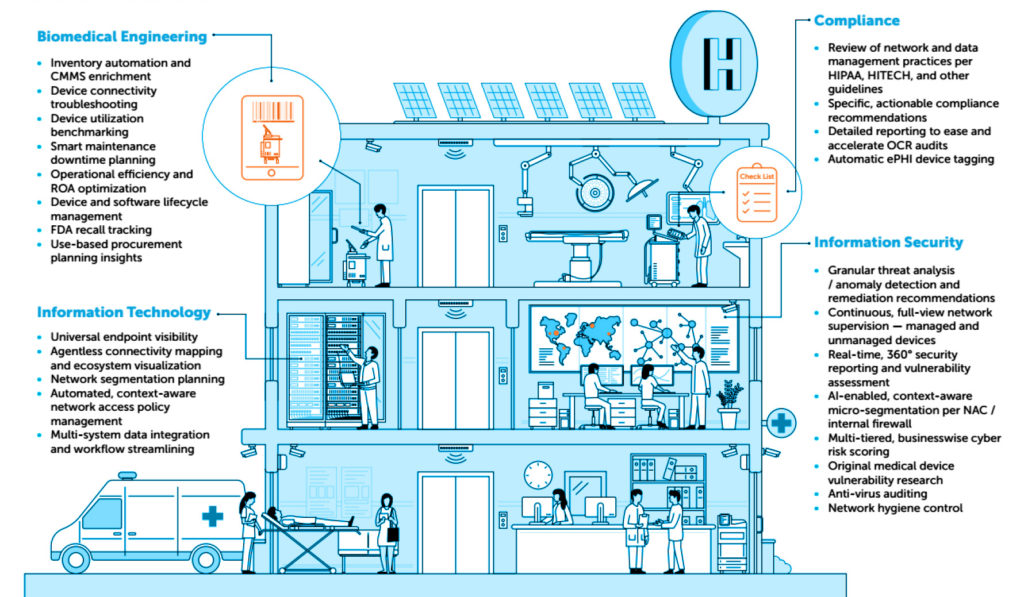Improving Clinical Operations Efficiency through Network Analytics

In any organization and in largely any industry, most network analytics are driven by IT. Healthcare providers are no exception. The insights extracted via network analytics offer serious opportunities for operational improvements and added value across departments. There are also significant ancillary benefits from a more cyber-aware and “plugged in” organizational posture — including improved information sharing, collaboration, and security.
Today, the challenges with smart network analytics have less to do with the availability of actionable insights and more to do with data “silos” and the respective cultural barriers to interdepartmental communication. As more connectivity is built into healthcare’s digital terrain of IT, IoT, OT and clinical assets (IoMT), interdepartmental communication becomes increasingly essential to promoting a secure organizational culture. In a hospital setting, perhaps the most acute benefit felt from taking network analytics beyond the corridors of the IT department is the value added to (and friction removed from) healthcare technology management (HTM) workflows.
Biomedical engineering in a clinical context
Biomedical or clinical engineers and technicians have a long list of important responsibilities. Among them, managing an organization’s fleet of connected devices — from procurement, inventory tracking and management to quality assurance, hardware maintenance and performance management to software patching and updating. Biomedical engineers are also responsible for decommissioning devices that have reached the end of their lifecycle, including disposing of them securely. Finally, they are responsible for ensuring the organization remains in compliance with all regulatory considerations related to connected devices and data privacy.
To put into perspective just how big of a job the biomed department is facing, modern medical facilities average 15-20 connected medical devices at each bedside. In 2022 there are a total of 920,531 staffed hospital beds across the U.S. That means there are between 13 and 19 million connected medical devices in use. The trend toward remote patient monitoring (RPM) alone will likely yield 70 million devices by 2025.
Because biomedical engineers are the de facto owners of medical devices, that increase in connectivity will mean more to manage.
The Need for Network Analytics in the Modern Hospital

Illustration: Hospital teams protecting the digital terrain
Analytics and automation have been advancing industrial productivity for decades. Over that time, the healthcare industry has been the exception. There are many reasons why healthcare has been a digital laggard. None of them come from a lack of applicability. In fact, there are many areas in healthcare that are leading the charge for smart technology applications. Whether it’s for more accurate diagnoses, customized treatments, patient comfort or the many examples in telehealth and telemedicine, a lot of technology innovation is happening in healthcare.
While some of these technologies process information at the edge, most rely on more traditional network computing models that relay data between endpoints to servers. There are also various nodes and workflows interacting along the way to intelligently process, share and action the information. When we inject data analytics into this connected ecosystem at the device or endpoint level, we can see the information being capturing from the field or patient and how it’s used. This type of information is typically reserved for the nurses, doctors and researchers involved in treatment and care processes.
At the network level, however, this connected ecosystem reveals information about the devices being used, how they’re being interacted with and how they’re processing data. This type of information is not only important for IT, data protection and compliance personnel but for HTM teams too. Network analytics exist one level up and one step removed from the point of care. It represents a form of meta data that informs not on individual care predicaments, but on organizational efficiencies and operational imperatives. This information can be leveraged to streamline processes, remove bottlenecks, pinpoint asynchronism, identify automation opportunities, improve resource allocation, or provide organization-wide visibility into critical assets.
It’s this type of network analytics that offers the most utility for biomedical engineers.
How do network analytics help biomedical engineers?
The starting point for most HTM tasks is medical device inventory management. Without a clear accounting of what you have in your possession and where, you can hardly be expected to keep them in fine working order.
In most hospitals, good inventory management is a lot easier said than done. When hospitals have hundreds or thousands of connected devices with a lifespan of 10 or more years, keeping track of every device that comes and goes and where it exists in its lifecycle is a tall task. Added to that is the criticality of medical devices, where failure means patient injury or death.
Leveraging intelligence from network-based cyber solutions, you can spot all the devices communicating in your network and build a live inventory of your connected devices. Pulling from network analytics, you can enrich that inventory with information on each device’s hardware, software and configurations. The network analytics unleashed by smart cyber tools can even help biomedical engineers locate the physical location of a device, reducing the need for surplus equipment stocks and improving time-to-response rates.
Network analytics can also help biomedical engineers understand which of their medical devices require patching or updating and with what urgency. It can help quantify which assets are being used most and least. In this way, when network analytics are put into the hands of biomedical engineers, they not only ensure smarter procurement decisions, but also support a prescriptive maintenance model based on the assets’ actual use and historical performance. Moreover, cybersecurity is increasingly considered a shared responsibility across the whole organization and encouraging the biomedical engineering team’s use of network analytics not only helps build cyber awareness and fluency, but it empowers them to directly communicate and collaborate with IT and security teams.
Here’s the bottom line
Biomedical teams are facing increasingly difficult medical device security challenges while shouldering greater responsibilities and facing more sophisticated (often structural) hurdles. They need data to act swiftly and with conviction. More often than not, that necessitates a close working relationship with IT and information security professionals. It’s critical these departments work together, using network analytics as a shared frame of reference and basis for operational improvement.
The potential to harness previously untapped synergies by sharing not only technology systems and insights, but a spirit of collaboration and shared responsibility is huge. To achieve peak efficiency and contribute to safer, higher quality outcomes for patients, this cultural shift must be nurtured. Great strides have been made through insight availability from cyber intelligence tools. Today, the key challenges are mostly organizational. Establishing a culture of data-driven processes, open communication and technology-enabled interdepartmental collaboration not only creates a more secure environment, but a more efficient one as well.
For More Information:
If you want to learn more, below are several sources for your reference.
- Datasheet – Medical Device Security Check List
- Interview – 9 questions on the urgency of medical device security
- Blog – A Hospital’s Cybersecurity: 10 Steps to Help Ensure Patient Safety and Continuous Operations
The post Improving Clinical Operations Efficiency through Network Analytics appeared first on Forescout.
*** This is a Security Bloggers Network syndicated blog from Forescout authored by Tamer Baker. Read the original post at: https://www.forescout.com/blog/improving-clinical-operations-efficiency-through-network-analytics/





